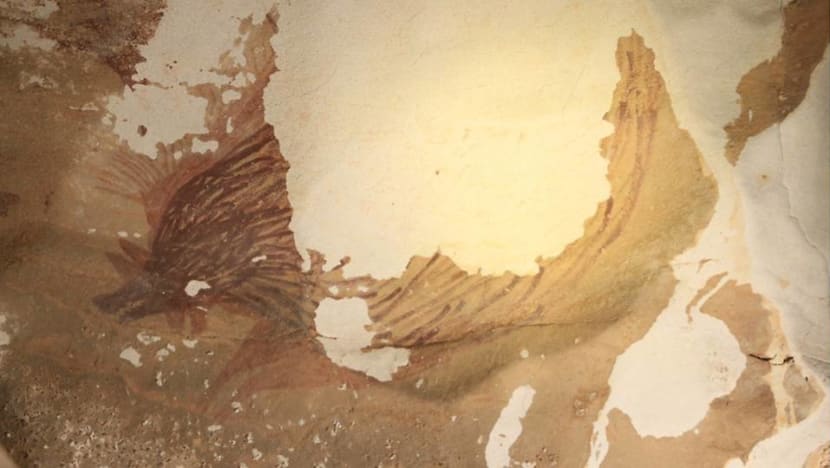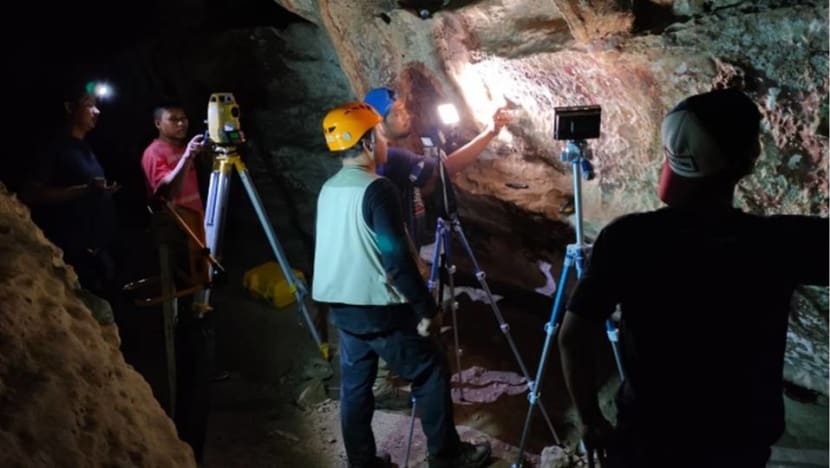'Globally significant’ 40,000-year-old rock art in Indonesia being destroyed by climate change

Climate change is quickly deteriorating priceless ancient rock art in Indonesia. (Image: Griffith University)
BANGKOK: Some of the world’s oldest and most significant rock art, created by ancient civilisations in South Sulawesi, is being destroyed at an alarming rate due to the impacts of climate change.
Research by experts at Australia’s Griffith University and Indonesian specialists shows how vivid and priceless cave motifs depicting animals, hunting scenes and supernatural beings are being damaged as temperatures increase and the weather becomes more extreme.
The team’s research paper, published in Scientific Reports last week, focuses on 11 limestone karst sites in Maros-Pangkep where discovered artworks date back more than 44,000 years. They are of global significance.
“The art was known since the 1950s but the antiquity of it has only been known since about 2014,” said Dr Jillian Huntley, rock art conservation specialist at Griffith University.
“What we’ve learnt from this rock art in South Sulawesi, in just one region, in just 10 or 11 years has completely changed what we thought we knew about the human story.

READ: How an illegal logger’s switch to a greener job shows a way to save Indonesia’s forests
“This is us. These are our ancestors, some of the very first humans in this region. We still don’t know very much about them. The discovery of this art has literally re-written textbooks,” she told CNA.
After surviving tens of thousands of years, the artworks are deteriorating quickly in fast-warming humid conditions.
The research shows that increased temperatures, consecutive dry days and powerful monsoon episodes are accelerating the build-up of salt crystals within the cave systems that contain the rock art.
“Water and salts are the most destructive agents of deterioration I’ve seen,” Dr Huntley said.
“It’s water coming through the stone and it’s also water being washed across the face of the stone. Particularly in environments where evaporation is really high, when the water comes through it picks up all these natural minerals that hold salt and when the water evaporates it drops out the crystals.
“On top of the rock face, the crystals actually chemically start to break down the really case-hardened surface.”

What is a fairly normal process has accelerated to the extent that motifs are simply crumbling away, in hundreds of sites across the region. Dr Huntley says in the approximately 300 known rock art sites across South Sulawesi, nearly all have been impacted.
“The art is there because it’s reached an equilibrium with its environment. But something like the acceleration of weathering under climate change, you tip that balance and something that’s lasted for more than 40,000 years can go, just like that. You start to see the impacts almost instantly,” she said.
If temperatures increase, due to the worsening effects of global warming, the researchers predict the art will be lost at an even faster rate, some likely to go before it can even be discovered across the vast and rugged archipelago.
“Almost without exception, the paintings are exfoliating and in advanced stages of decay. We are in a race against time,” Adhi Agus Oktaviana, an Indonesian rock art expert with the National Research Centre for Archaeology (ARKENAS) said in a statement.

The issue is being exacerbated by rice fields and aquaculture ponds used by locals to grow food, as these contribute to humidity, evaporation and the amounts of water being retained in the environment. Industrial development is also considered a threat.
The experts have called for more resources to be able to do a regional risk assessment and speed up their ability to discover and survey more artworks.
READ: This city in Java could disappear in 15 years, due to land subsidence and coastal flooding
Local conservation groups have started a monitoring program, but mitigation efforts on a landscape-scale may be required to safeguard the art. This is difficult when heritage is in contest with the needs of the local population, such as food security.
“We’re still playing catch-up because we’re only starting to realise how much art is out there and how globally significant it is,” Dr Huntley said. “We need to get in and document these things as best as we can, as quickly as we can.”














